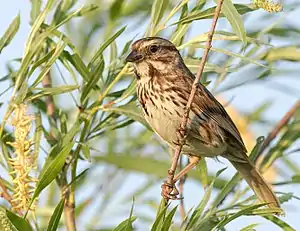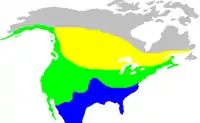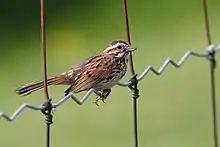Singammer
Die Singammer (Melospiza melodia) ist eine nordamerikanische Singvogelart, die sich in 31 Unterarten unterteilt.
| Singammer | ||||||||||||
|---|---|---|---|---|---|---|---|---|---|---|---|---|

Singammer (Melospiza melodia) | ||||||||||||
| Systematik | ||||||||||||
| ||||||||||||
| Wissenschaftlicher Name | ||||||||||||
| Melospiza melodia | ||||||||||||
| (Wilson, 1810) |

gelb:Brutgebiet
grün:Vorkommen als Standvogel
blau:Überwinterungsgebiet

Merkmale
Der Vogel ist an der Oberseite braun mit dunklen Streifen am Rücken und an der Unterseite weiß mit dunkler Sprenkelung und einem dunklen Fleck auf der Brust. Er hat eine braune Haube und einen langen braunen Schwanz. Die verschiedenen Unterarten weichen in der Färbung voneinander ab. Der melodiöse und komplexe Gesang dient zur Revierverteidigung und zum Anlocken des Weibchens.
Vorkommen
Der Vogel lebt in Gebüschen und Dickichten in Wassernähe, in Sümpfen und Salzmarschen in weiten Teilen von Kanada, der USA und dem nördlichen Mexiko. Die Vögel aus dem nördlichen Verbreitungsgebiet ziehen in der kalten Jahreszeit bis nach Mexiko. Aus Norwegen und Großbritannien wurden wenige Sichtungen berichtet. Die Santa-Barbara-Singammer war auf der Insel Santa Barbara Island vor Kalifornien endemisch und gilt inzwischen als ausgestorben.
Verhalten
Dieser Vogel sucht am Boden, im Gestrüpp oder im seichten Wasser nach Insekten und Samen. In Salzmarschen ergänzen Krustentiere die Nahrung.
Fortpflanzung
Das Weibchen baut ein Schalennest aus Gras und Stängeln am Boden im Dickicht und bebrütet drei bis fünf Eier etwa zwei Wochen lang. Das Männchen hilft bei der Aufzucht der Jungen, die nach zwei Wochen flügge werden, und versorgt die Jungvögel noch etwas länger, während das Weibchen nochmals brütet. Selbst drei Bruten in einem Jahr sind nicht ungewöhnlich.
Unterarten
Es sind vierundzwanzig Unterarten anerkannt:[1]
- Melospiza melodia maxima Gabrielson & Lincoln, 1951[2] kommt auf den westlichen Aleuten vor.
- Melospiza melodia sanaka McGregor, 1900[3] ist auf den östlichen Aleuten und an der Spitze der Alaska-Halbinsel verbreitet.
- Melospiza melodia insignis Baird, SF, 1869[4] kommt auf Kodiak Island und dem östlichen Gebiet des der Alaska-Halbinsel vor.
- Melospiza melodia kenaiensis Ridgway, 1900[5] ist an den Küsten Alaskas verbreitet.
- Melospiza melodia caurina Ridgway, 1899[6] ist an den Küsten des südöstlichen Teils Alaskas verbreitet.
- Melospiza melodia rufina (Bonaparte, 1850)[7] kommt auf den Inseln südöstlich von Alaska und im westlichen Kanada vor.
- Melospiza melodia merrilli Brewster, 1896[8] ist im östlichen Teil British Columbias bis in den südöstlichen Teil Washingtons, den nordöstlichen Teil Kaliforniens und das nördliche Gebiet Nevadas verbreitet.
- Melospiza melodia morphna Oberholser, 1899[9] kommt im zentralen sowie südwestlichen Teil British Columbias bis ins nordwestliche Oregon vor.
- Melospiza melodia cleonensis McGregor, 1899[10] ist vom südwestlichen Oregon bis ins nordwestliche Kalifornien verbreitet.
- Melospiza melodia gouldii Baird, SF, 1858[11] ist an der Mittelküste Kaliforniens mit Ausnahme der San Francisco Bay Area und auf Santa Cruz Island verbreitet.
- Melospiza melodia samuelsis (Baird, SF, 1858)[12] kommt in der Bucht von San Pablo und dem nördlichen Teil der San Francisco Bay Area vor.
- Melospiza melodia maxillaris Grinnell, 1909[13] ist in der Suisun Bay verbreitet.
- Melospiza melodia pusillula Ridgway, 1899[14] kommt im südlichen Teil der San Francisco Bay Area vor.
- Melospiza melodia graminea Townsend, CH, 1890[15] ist auf den Kanalinseln und den Islas Coronado verbreitet.
- Melospiza melodia heermanni Baird, SF, 1858[16] kommt im zentralen und südwestlichen Kalifornien sowie dem nördlichen Niederkalifornien vor.
- Melospiza melodia rivularis Bryant, WE, 1888[17] ist im südlichen Niederkalifornien verbreitet.
- Melospiza melodia fallax (Baird, SF, 1854)[18] kommt im südlichen Nevada, südlichen Utah, in Arizona und nordwestlichenw Mexiko vor.
- Melospiza melodia goldmani Nelson, 1899[19] ist im nordwestlichen bis ins westliche zentrale Mexiko verbreitet.
- Melospiza melodia mexicana Ridgway, 1874[20] ist im südlichen zentralen Mexiko verbreitet.
- Melospiza melodia villai Phillips, AR & Dickerman, 1957[21] kommt in Zentralmexiko vor.
- Melospiza melodia adusta Nelson, 1899[22] ist im westlichen zentralen Mexiko verbreitet.
- Melospiza melodia montana Henshaw, 1884[23] kommt im westlichen zentralen Gebiet der USA vor.
- Melospiza melodia melodia (Wilson, A, 1810)[24] ist vom südlichen zentralen und südlichen östlichen Teil Kanadas bis ins südöstliche Gebiet der USA mit Ausnahme der Atlantikküste verbreitet.
- Melospiza melodia atlantica Todd, 1924[25] ist an der Küste des östlichen zentralen Teils der USA verbreitet.
Literatur
- Colin Harrison & Alan Greensmith: Vögel. Dorling Kindersley Limited, London 1993, 2000, ISBN 3-831-00785-3
- Bryan Richard: Vögel. Parragon, Bath, ISBN 1-405-45506-3
- Spencer Fullerton Baird: Descriptions of New Birds collected between Albuquerque, N. M., and San Francisco, California, during the Winter of 1853-54, by Dr. C.B.R. Kennerly and H.B. Mollhausen, naturalists attached to the survey of Pacific R.R. Route, under Lt. A. W. Whipple. In: Proceedings of the Academy of Natural Sciences of Philadelphia. Band 7, 1854, S. 118–120 (biodiversitylibrary.org).
- Spencer Fullerton Baird in Spencer Fullerton Baird John Cassin, George Newbold Lawrence: Reports of explorations and surveys, to ascertain the most practicable and economical route for a railroad from the Mississippi River to the Pacific Ocean. Made under the direction of the Secretary of War, 19 1853-6. according to acts of congress of March 3, 1853, Mai 31, 1854, and August 5, 1854. Band 9. A. O. P. Nicholson, Printer, Washington 1858 (biodiversitylibrary.org – a).
- Spencer Fullerton Baird: Dr. Abbot read a description of a new sparrow collected by Mr. Samuels in California, and described by S. F. Baird, Esq., of the Smithsonian Institute, as follows. In: Proceedings of the Boston Society of Natural History. Band 6, 1858, S. 379–380 (biodiversitylibrary.org – b).
- Spencer Fullerton Baird: On Additions to the Bird-Fauna of North America, made by the Scientific Corps of Russo-American Telegraph Expedition. In: Transactions of the Chicago Academy of Sciences. Band 1, 1869, S. 311–325 (englisch, babel.hathitrust.org [PDF; 433 kB]).
- Charles Lucien Jules Laurent Bonaparte: Conspectus generum avium. Band 1. E. J. Brill, Leiden 1850 (biodiversitylibrary.org).
- William Brewster: Descriptions of a New Warbler and a New Song Sparrow. In: The Auk. Band 13, Nr. 1, 1896, S. 44–47 (englisch, sora.unm.edu [PDF; 167 kB]).
- Walter E. Bryant: Description of a new Subspecies of Song Sparrow from Lower California, Mexico. In: Proceedings of the California Academy of Sciences (= Second Series). Band 1, 1888, S. 197–200 (biodiversitylibrary.org).
- Ira Noel Gabrielson, Frederick Charles Lincoln: The Races of Song Sparrows in Alaska. In: The Condor. Band 53, Nr. 5, 1951, S. 250–255 (englisch, sora.unm.edu [PDF; 433 kB]).
- Joseph Grinnell: Three new song sparrows from California. In: University of California publications in zoology. Band 5, Nr. 3, 9. April 1909, S. 265–269 (biodiversitylibrary.org).
- Henry Wetherbee Henshaw: Description of a New Song Sparrow from the Southern Border of the United States. In: The Auk. Band 1, Nr. 3, 1884, S. 223–224 (englisch, sora.unm.edu [PDF; 92 kB]).
- Richard Crittenden McGregor: New Alaska Birds. In: Bulletin of the Cooper Ornithological Club. Band 1, Nr. 5, 1899, S. 87–88 (englisch, sora.unm.edu [PDF; 171 kB]).
- Richard Crittenden McGregor: New Alaska Birds. In: The Condor. Band 3, Nr. 1, 1900, S. 8 (englisch, sora.unm.edu [PDF; 46 kB] 1901).
- Edward William Nelson: Descriptions of New Birds from Mexico. In: The Auk. Band 16, Nr. 1, 1899, S. 25–31 (englisch, sora.unm.edu [PDF; 266 kB]).
- Alexander Wilson: American Ornithology or, the Natural History of the Birds of the United States: Illustrated with Plates Engraved and Colored from Original Drawings taken from Nature. Band 2. Bradford and Inskeep, Philadelphia 1810 (biodiversitylibrary.org).
- Robert Ridgway: A history of North American birds. Little Brown, Boston 1874 (biodiversitylibrary.org).
- Robert Ridgway: New Species, etc., of American Birds. -- III. Fringillid[ae] (Continued). In: The Auk. Band 16, Nr. 1, 1899, S. 35–37 (englisch, sora.unm.edu [PDF; 126 kB]).
- Robert Ridgway: New Species, Etc., of American Birds. -- VI. Fringillid[Ae] (Supplement). In: The Auk. Band 17, Nr. 1, 1900, S. 29–30 (englisch, sora.unm.edu [PDF; 76 kB]).
- Walter Edmond Clyde Todd: A New Song Sparrow from Virginia. In: The Auk. Band 41, Nr. 1, 1924, S. 147–148 (englisch, sora.unm.edu [PDF; 96 kB]).
- Charles Haskins Townsend: Scientific results of explorations by the U. S. Fish Commission steamer Albatross. No. XIV..Birds from the coasts of western North America and adjacent islands, collected in 1888-89, with descriptions of new species. In: Proceedings of the United States National Museum. Band 13, 1890, S. 131–142 (biodiversitylibrary.org).
- Harry Church Oberholser: The Names of the Song Sparrows. In: The Auk. Band 16, Nr. 2, 1899, S. 182–183 (englisch, sora.unm.edu [PDF; 100 kB]).
- Allan Robert Phillips, Robert William Dickerman: Notes on the Song Sparrows of the Mexican Plateau. In: The Auk. Band 74, Nr. 3, 1957, S. 376–382 (englisch, sora.unm.edu [PDF; 376 kB]).
Weblinks
- Melospiza melodia in der Roten Liste gefährdeter Arten der IUCN 2008. Eingestellt von: BirdLife International, 2008. Abgerufen am 31. Januar 2009.
- Videos, Fotos und Tonaufnahmen zu Melospiza melodia in der Internet Bird Collection
- Federn der Singammer
Einzelnachweise
- IOC World Bird List New World sparrows, bush tanagers
- Ira Noel Gabrielson u. a. (1951), S. 251.
- Richard Crittenden McGregor (1900), S. 8.
- Spencer Fullerton Baird (1869), S. 319, Tafel 29 Abbildung 2.
- Robert Ridgway (1900), S. 29.
- Robert Ridgway (1899), S. 36.
- Charles Lucien Jules Laurent Bonaparte (1850), S. 477.
- William Brewster (1896), S. 46.
- Harry Church Oberholser (1899), S. 183.
- Richard Crittenden McGregor (1899), S. 87.
- Spencer Fullerton Baird (1858a), S. 477 & 479.
- Spencer Fullerton Baird (1858b), S. 379.
- Joseph Grinnell (1909), S. 265.
- Robert Ridgway (1899), S. 35.
- Charles Haskins Townsend (1890), S. 139.
- Spencer Fullerton Baird (1858a), S. 477 & 478.
- Walter E. Bryant (1888), S. 197.
- Spencer Fullerton Baird (1854), S. 119.
- Edward William Nelson (1899), S. 29.
- Robert Ridgway (1874), S. 18.
- Allan Robert Phillips u. a. (1957), S. 380.
- Edward William Nelson (1899), S. 28.
- Henry Wetherbee Henshaw (1899), S. 224.
- Alexander Wilson (1810), S. 125, Tafel 16 Abbildung 4.
- Walter Edmond Clyde Todd (1924), S. 147.